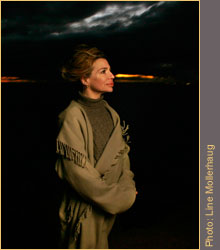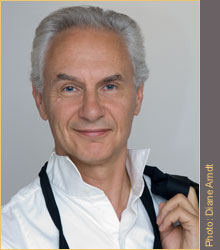


Gelsey Kirkland and Michael "Misha" Chernov
When Gelsey Kirkland arrived at American Ballet Theatre in 1974 it was the beginning of the transformation of the company. In much the same way that Mikhail Baryshnikov raised the bar(re) for male dancers, Kirkland created a new paradigm for the modern ballerina. No matter the turbulence that followed in her personal life, it was her artistry and technique on stage that astonished audiences around the world. Especially in the great ballerina roles like Giselle and Swan Lake, her performance seemed to emerge spontaneously as though the steps were being invented only as she danced them.
Gelsey Kirkland in Giselle
It was all illusion. What seemed to be effortlessness was the result of her relentless determination and intensive study to reach that elusive point of perfect grace. Most of what Kirkland learned she had to seek out on her own. It wasn't being taught in American ballet schools. As she says,
In my career I was always a student trying to understand what I was doing. I'm a very analytical person and I had a lot of great relationships with teachers, long term one-on-one work, that inspired me to search for knowledge. I was always painfully aware that there were areas that I knew nothing about so it was an ongoing journey.
Now Kirkland, with her husband and partner Michael Chernov, are providing a complete education for dancers at the Gelsey Kirkland Academy of Classical Ballet. The GKACB is a place where dancers can learn to become artists.
After retiring from the stage in 1986, Kirkland began teaching with the encouragement of her first husband, Greg Lawrence, but felt that something important was missing. Kirkland said,
I had that whole career and had no clue that you had to be trained to be a teacher. No idea at all. I'm sure that most dancers experience this. They think, "I can go and teach." And then it's a traumatic experience because they don't know what they're doing. What they do is perform the steps. That's what I did. And then you think that you're teaching and the kids love it because you're showing them how to do everything. But take away that performance and you're left with, "whoops... I don't know what I'm doing."
Imitating her performance was not teaching dancers how to work best with their own bodies. Kirkland came to agree with Chernov that the only way to have a lasting impact on students was to create their own academy. They set about learning the craft of teaching ballet by spending a year with Nina Osipyan, one of the great teachers of Russia's famed Vaganova method as taught at the Kirov Ballet. This is the same school of ballet that produced Nijinsky, Balanchine, Nureyev, Baryshnikov and Natalia Makarova. By any criteria, the Vaganova system works. The curriculum at GKACB also includes instruction in music theory, acting, character dancing, mime, partnering and body conditioning in addition to classical ballet technique.
The choice of the Vaganova technique will come as a surprise to some people who know the art of ballet. It is highly regimented and specific about what must be taught and when, along with mandatory and rigorous testing. Detractors feel that it places too much strain on developing bodies by forcing the legs to turn out unnaturally. In Kirkland's estimation, the Vaganova system is flexible and allows her to bring to it what she knows.
All of the things that I've learned are being taught. You teach what's good, right? Just because you teach a system doesn't mean you don't maintain the principles that you believe in. We also do the Bournonville here all the time because it's necessary for them to learn how to bind steps. We bring that in and it's a totally different system but it coordinates.
The Danish Bournonville system places greater emphasis on verticality with small jumps and refined footwork which is something Kirkland deems necessary to develop fluidity of movement. Chernov goes on to say, "There are factions, of course. Some people hate Russian teaching, some people love it. But it's a system, not a nationality. It's an intelligent and proven system that works."
To prevent the harm that comes from dancers forcing their hips to turn out, many of Kirkland's exercises at the barre begin with the feet in parallel position. Students then must use only their muscles to turn their legs out from the hip bones, thereby preventing them from over-stressing the knees, ankles and feet. Everything at GKACB is centered on working intelligently and in a way that is healthy for both mind and body.
It can be a difficult lesson for dancers to learn that their hips will not rotate 180 degrees but it is essential to their future physical well-being. Kirkland acknowledges,
It's a long process because they're horrified at the truth of -- "that's all I've got?" What we try to help them see is that the audience is in front of them, not on the side, and the amount of real rotation that they have has the ability to express and radiate but with false rotation the whole body goes backwards.
Core Dynamics, the class that begins each day at the GKACB, is derived from the Pilates-based teachings of Reas Reyneke, with whom Kirkland studied in London. It is so integral a part of what they do at GKACB that they can't imagine teaching without it. Said Kirkland,
Part of the school's mission is to re-train dancers who have developed bad habits through uninformed training. Core Dynamics helps to isolate many of those trouble spots. The upper body can be changed pretty quickly and responds very well but sometimes the lower body has more limitations. You have to isolate the muscle groups from the ones that want to work automatically and get them to release and then the ones that don't want to work you have to engage. Starting out in ballet standing up is one of the biggest mistakes, especially with remedial training.
The body can't be a channel for expression without being centered and understanding how all the extremities work from the center. Great training systems (like Vaganova) have related exercises that they do with kids that are set up before they do Year One. They don't come into ballet on their feet. But it's all behind the scenes... hidden work.
Sophie Folts, a student in the Pre-professional Program, admits, "I was initially skeptical about Core Dynamics because I was conditioned to thinking that I wasn't really doing anything unless I felt the burn. It took some time but now I don't feel right unless I start the day out with it. It makes me feel calm and strongly centered."
Pilar Garcia, who teaches mime at GKACB, has worked closely with Kirkland for over thirty years. Her contribution is essential to the mission of building better dancers by teaching them how to draw the audience into their performance. Kirkland explained the importance is of mime in a dancer's skill set:
Pilar brings in the acting side of it, all of the questions you have to ask: who, what, when, where and why; each moment to moment, in each scene, what you have to accomplish; what you're saying to your partner and what the relationship is. It's just like in a play but you have no words. You have to know what actions you're taking and the through-line of the story you're telling which you only see superficially in the libretto. It's in the philosophical or poetic realm. You have to be able to access what it is you're trying to accomplish so that you can draw the audience in. It's a very close relationship and you have to have a common vision to pull it all apart and put it back together again, moment by moment.
There is a definite air of positive attitudes among the students. Ms. Folts concurs, "This place has the most supportive atmosphere I've ever been in. Not that there isn't competition, because there always is, but its feels healthy. The most important thing is that it's supportive and that's important to me"
Ms. Folts went on to explain a couple of other things that she found here to be very different where she had studied dance before. She likes that, "They don't just tell you to do things, they explain how muscles work and why they sometimes don't. I've learned about bones and muscles I didn't even know I had. I also feel like I'm working more on the artistry and not just the technique."
The GKACB has implemented a comprehensive, one-of-a-kind Wellness Program. Incoming students are given an assessment along with specific instruction. They are making sure that students understand their nutritional requirements. Gelsey Kirkland had trouble with an eating disorder during her career and the school is highly proactive in ensuring that students don't fall into self-destructive habits. They also track all injuries to make sure that there is no pattern of recurring chronic problems. As Kirkland says, "We're cultivating a positive mind-body image. The main thing is to give them the right training to get them out of the mirror."
With respect to fostering healthy minds and bodies, Chernov added,
We've also just begun a rehabilitation program. It's for dancers who've had a career or are still dancing who've had problems with drugs, eating disorders or psychological problems. We want to provide them with a supportive artistic environment where they can really learn instead of competing with no specific result at the end necessary. In other words, if it goes on to help them re-establish their careers or just enjoy dancing or teaching, that's all good. I think dancers will want to hear about this. Again, we need funding.
When I asked Kirkland what she was most proud of with the GKACB, she took her time before answering:
I'm proud of myself for persevering and enduring and realizing that it's an impossible task unless you do it with a team. I think that we're developing an amazing team here. I can actually see that the effort that we're making is important to students. I was teaching before and Misha (Chernov) said that it's a waste of time if you teach in an open situation; (meaning open classes where anyone can come in) there's nothing you can do except confuse the kids. They get so much contradictory information.
I'm also very proud of the kids here that are pushing through this process, taking the information we give them and making it their own. I hope it continues to gain support. I believe in the knowledge that we're passing on to the students. We just need more funding to continue to grow and compete with the bigger schools. We need funding to develop a studio company to give the advanced students more performance opportunities.
Looking toward the future, Kirkland and Chernov have a dream of eventually moving the academy out to Governors Island. As to why she would like to be out there, Kirkland said,
It's obvious that it's a perfect place for dormitories and studios and a safe haven for students. It's the perfect place for classical training because it's quiet and it's restful. We're doing a lot of remedial work with our students. Our most ambitious scenario is that we'd like to get the students earlier, before they need remedial work. We need a place to bring them to.
Chernov echoed her sentiments on moving to Governors Island with some additional information:
We have done an assessment with an architect, we've done the drawings and we have the plans, we've had contractors out there and we've got a price but it's nothing that we can afford. It would take $6 million. We need someone who has the funds to fall in love with our idea and we haven't found that person yet.
N.B. The Gelsey Kirkland Academy of Classical Ballet is a 501(c) (3) non-profit organization. All donations are fully tax deductible.
On September 8th, the Gelsey Kirkland Academy of Classical Ballet, 355 Broadway, will have an open house to welcome children who are beginning students, email: info@gelseykirklandballet.org.
